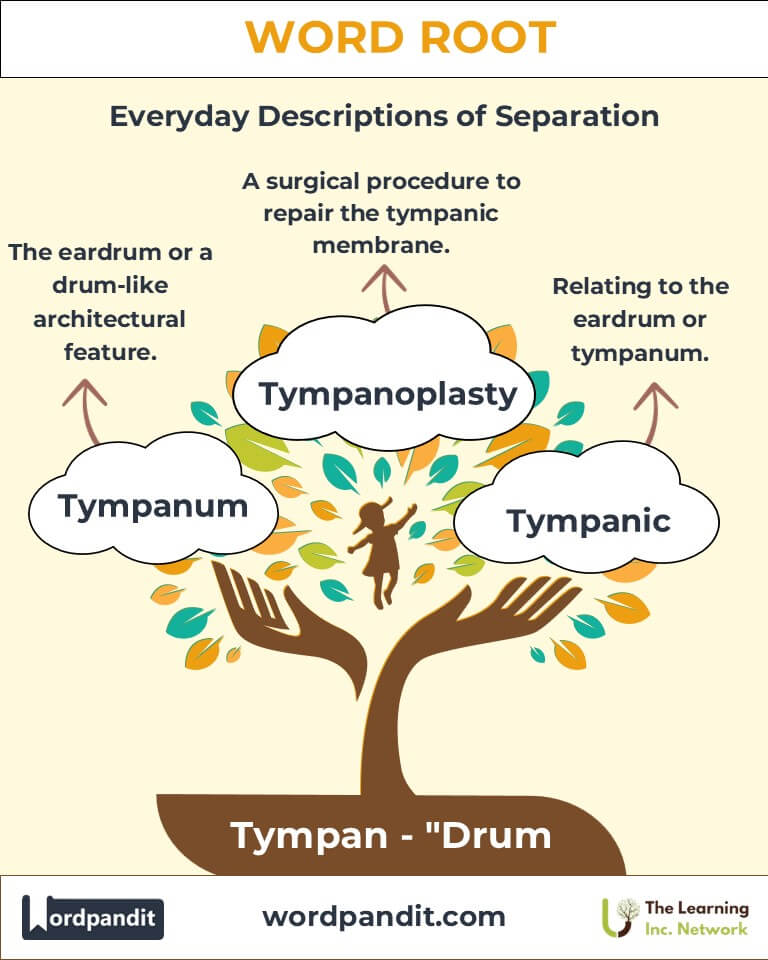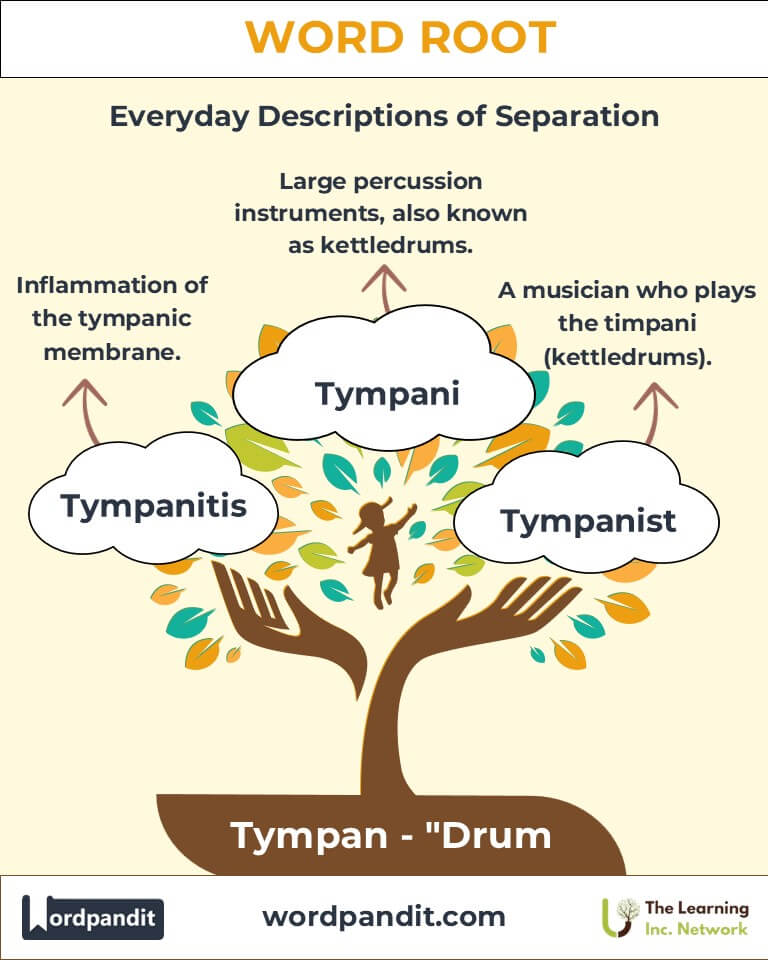Tympan: The Resonant Root of Sound and Structure
Discover: The versatility of the word root "tympan," meaning "drum." From anatomical terms like the tympanum to musical innovations, this root reverberates through language, science, and culture, illustrating the rhythmic essence of life.

Table of Contents
- Introduction: The Resonance of Tympan
- Etymology and Historical Journey
- Mnemonic: Remembering Tympan
- Common Tympan-Related Terms
- Tympan Through Time
- Tympan in Specialized Fields
- Illustrative Story: Tympan in Action
- Cultural Significance of Tympan
- The Tympan Family Tree
- FAQs about the Tympan Word Root
- Test Your Knowledge: Tympan Word Root Quiz
- Conclusion: The Living Legacy of Tympan
1. Introduction: The Resonance of Tympan
The word root "tympan" (pronounced tim-pan) originates from the Greek word tympanon, meaning "drum." This versatile root captures the essence of vibration and sound, from the tympanic membrane in the human ear to the tympan in printing presses. Its relevance spans fields like anatomy, music, and engineering, symbolizing both rhythm and resonance.

2. Etymology and Historical Journey
The root "tympan" derives from the Greek tympanon, which referred to a handheld drum used in rituals and celebrations. Over time, the term expanded into Latin and Middle English, evolving to describe not just drums but structures and membranes associated with sound production and transmission. The tympanic membrane, for example, became a central term in anatomy, reflecting its drum-like role in the auditory system.
3. Mnemonic: Remembering Tympan
Imagine the rhythmic beat of a drum, each vibration mirroring the function of the tympanic membrane in transmitting sound. To remember "tympan," think:
"Tympan taps the rhythm of sound and structure."
4. Common Tympan-Related Terms
- Tympanic (tim-pan-ik):
Definition: Relating to the tympanum or eardrum.
Example: "The tympanic membrane vibrates in response to sound waves." - Tympanum (tim-puh-num):
Definition: The eardrum or a drum-like architectural feature.
Example: "The tympanum of the church was adorned with intricate carvings." - Tympanoplasty (tim-puh-no-plas-tee):
Definition: Surgical repair of the tympanic membrane.
Example: "The patient underwent a tympanoplasty to restore hearing." - Tympanist (tim-puh-nist):
Definition: A musician who plays the timpani (kettledrums).
Example: "The tympanist's performance added depth to the orchestra." - Tympanitis (tim-puh-nai-tis):
Definition: Inflammation of the tympanic membrane.
Example: "Tympanitis can cause temporary hearing loss and discomfort."
5. Tympan Through Time
- Ancient Tympanum: Initially used to describe a ceremonial drum, the term expanded to include the eardrum due to its drum-like function in the body.
- Modern Tympanic Innovations: The development of tympanoplasty in the 20th century revolutionized hearing restoration.
6. Tympan in Specialized Fields
- Medicine:
- Tympanic Membrane: A critical component of the auditory system, transmitting sound vibrations to the inner ear.
- Application: Diagnoses of tympanitis or perforations often guide treatment plans.
- Music:
- Tympani (Kettledrums): Integral to orchestras, tympani embody the rhythmic heritage of the tympan root.
- Impact: Adds depth and drama to symphonic compositions.
- Architecture:
- Tympanum in Buildings: The triangular space above a doorway, often decorated with relief sculptures.
- Significance: Reflects the drum-like echo of ancient ceremonial tympana.
7. Illustrative Story: Tympan in Action
During a stormy night, Elena, an audiologist, treated a patient with a ruptured tympanic membrane. Inspired by the rhythmic patter of rain, she explained how the eardrum resembles a drum, transmitting sound vibrations to the brain. Across town, a tympanist practiced for an orchestral concert, his instrument echoing the natural rhythms of life. Both stories highlight the interconnectedness of tympan-related concepts in art and science.
8. Cultural Significance of Tympan
The drum has symbolized communication and celebration in cultures worldwide, from ancient rituals to modern music. In architecture, the tympanum often adorned sacred spaces, echoing the divine rhythms of life. This root underscores humanity’s enduring relationship with sound, rhythm, and harmony.

9. The Tympan Family Tree
- Son (Sound):
Example: Sonic (relating to sound). - Phon (Voice/Sound):
Example: Phonograph (a device for recording sound). - Membran (Thin Layer):
Example: Membrane (a thin, pliable layer). - Drum (Percussion):
Example: Drumstick (a tool for playing drums).

10. FAQs About " Tympan "
Q: What does the root "Tympan" mean?
A: The root "Tympan" originates from the Greek word tympanon, meaning "drum." It is commonly associated with structures or instruments resembling a drum, both in shape and function, such as the eardrum in anatomy or tympani in music.
Q: What is the tympanic membrane?
A: The tympanic membrane, commonly known as the eardrum, is a thin, circular membrane that separates the outer ear from the middle ear. It vibrates in response to sound waves, playing a crucial role in hearing.
Q: How is "Tympan" used in music?
A: In music, "Tympan" refers to tympani, also known as kettledrums. These percussion instruments consist of a large, drum-like surface that produces deep, resonant sounds when struck, similar to the root’s original meaning of "drum."
Q: What is tympanoplasty?
A: Tympanoplasty is a surgical procedure to repair the tympanic membrane (eardrum) or the small bones in the middle ear. It is often performed to improve hearing or treat chronic ear infections.
Q: How does "Tympan" relate to architecture?
A: In architecture, a tympanum is the semi-circular or triangular decorative surface over an entrance, typically adorned with carvings or reliefs. It draws its name from its drum-like, enclosed shape.
11. Test Your Knowledge: " Tympan " Mastery Quiz
1. What does the root "Tympan" signify?
2. What is the tympanic membrane?
3. What are tympani in music?
4. What does tympanoplasty involve?
5. What is a tympanum in architecture?
12. Conclusion: The Living Legacy of Tympan
From the rhythmic beats of a drum to the intricate mechanics of the ear, the root "tympan" symbolizes the universality of sound and structure. Its applications in medicine, music, and architecture illustrate how this root continues to resonate through our lives. Embrace the rhythm of "tympan" as a reminder of life’s vibrant connections!












